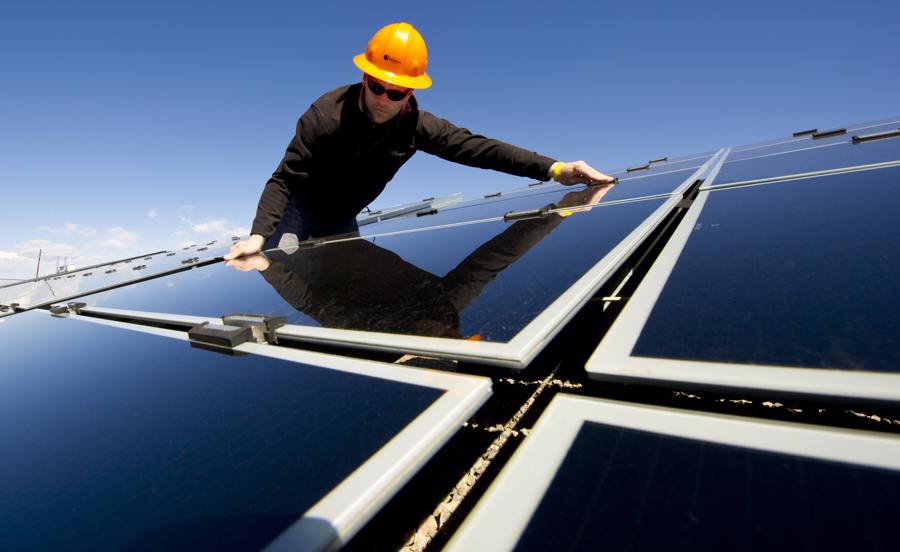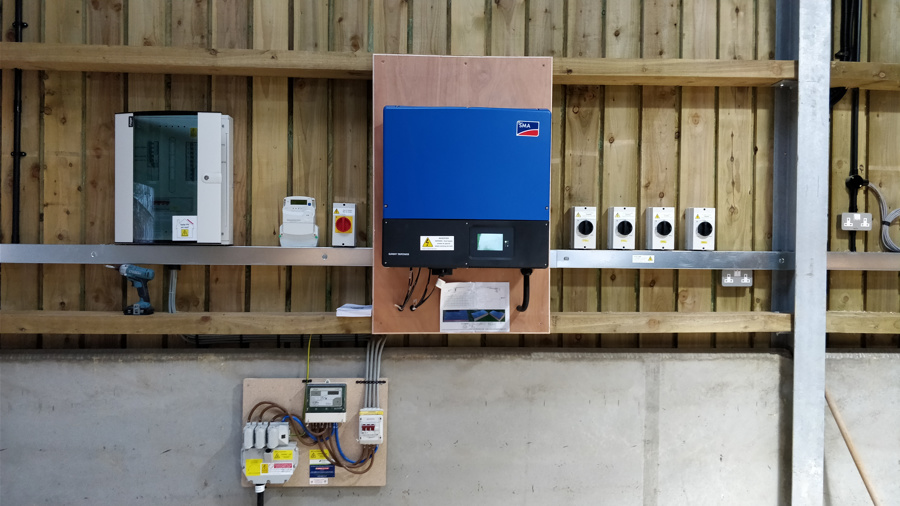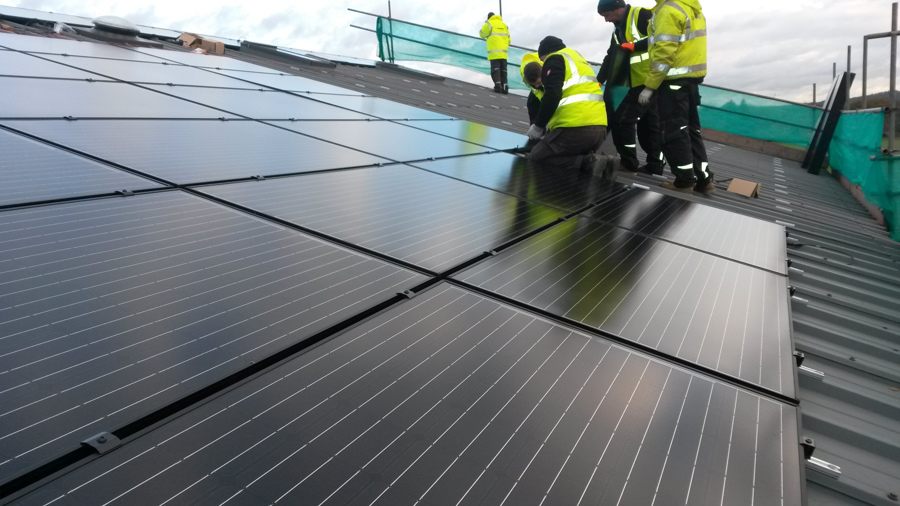
Solar Photovoltaic Panels (PV)
What is Solar PV?
A solar PV system generates electricity from the sun’s radiation to power equipment in your home and to export to the National Grid.
There are two main parts to a PV system: the panels on the roof or on framework attached to the ground, and a solar inverter that converts the electricity generated by the panels to AC electricity compatible with the mains electricity in your house and the National Grid.
How does solar PV work?

Solar PV panels are made of a crystalline semiconductor (silicon) material of silicon treated and connected together to form photodiodes. When the sun’s radiation hits the PV panels, the photodiodes convert the solar energy into DC electricity. Many diodes arte connected together to create the output of the panel, and the output from the panels is connected to forma a large array. The panels need to be mounted facing as directly into the sun as possible. Normally they are fitted on a south-facing roof or on a standalone structure on the ground. They will work but at reduced output on east or west facing roofs.
The panels will only generate electricity when they are illuminated – so they don’t work at night and produce a great deal more when the sky is not clouded. Because of this they will produce about ten times more electricity on average in the summer when the days are longer and the weather better than the winter when on some days the generation will be negligible.
What are solar inverters?
The electricity from the array of panels is DC and not directly usable by most household appliances and cannot be connected to the grid. To convert it to a usable form, the panels are connected to a solar inverter. The inverter is an electronic device that receives the DC current and converts it to AC current at the same voltage as the mains.

When the PV system is generating power it will flow directly from the inverter into appliances in the house that are switched on. The power will be automatically topped up by additional electricity from the national grid if that is needed. If you are not using or storing the electricity as it is being generated, then it will flow into the National Grid, so someone else can use it.
Both the panels and the inverter are essential parts of the PV system.
The performance of panels, the power they can generate per square metre, has increased significantly over the years so that either fewer panels are needed for the same or more powerful systems are possible. While panels may fail, in general panels are very reliable pieces of equipment. Spending more on better panels will normally give a higher power output from the same area or a panel that is more aesthetically pleasing.
Inverters are a complex piece of high power electronics. They take some power to work themselves and so cannot be 100% efficient. It is important to have a correctly sized inverter for the size and type of array to maximise the efficiency. The power they use themselves generates heat and the inverter may get hot and will be under some stress. Like any electronic equipment some brands perform better than others. Where there are failures in PV systems it is normally the inverter that breaks down and needs to be repaired or replaced. It is worth buying a good quality inverter from a reputable manufacturer with a meaningful guarantee.
What are the benefits of solar PV?
The amount of electricity generated varies from year to year with the weather and also depends on the location in the country, the direction the array faces and whether the array is shaded by neighbouring buildings or trees.
People normally talk about the size of an array in terms of the peak power it can generate in full sunshine. So a 3.6kWp array can generate 3.6 kW of power in full sun. An array like this running for one hour will generate 3.6kWh (or units) of electricity. It will only generate like this during daylight, when the array is exposed to the sun and it is not cloudy. At other times the output will be less. A typical, well-sited PV array in the centre of Britain will normally generate around 900 – 1000 kWh/year/kWp. So a 3.6kWp array is likely to generate about 3600 kWh/year. About 75% of the generation will be in the spring and summer months.

The benefits of the PV array derive from this generation.
The electricity generated does not produce CO2Based on the mix of fuels used in Britain’s power generation system today 3600 kWh generated cleanly saves about 0.8 tonne of CO2. That is a worthwhile contribution if we suppose that each person in the UK is responsible for about 10 tonnes of emissions each per year.
The electricity you generate and use yourself is saved from your electricity billIf you can use all of the 3600 kWh/year you generate you will save about £800 / year at today’s prices. You are more likely to use more of the electricity you generate if you have an electric vehicle, work from home or have a battery storage system.
The feed-in-tariffs to incentivise no longer exist, but the Government (Ofgem) still run the Smart Export Guarantee scheme where electricity suppliers may pay you small amounts for electricity you generate and export to the grid. It is worth checking with your supplier whether you can sign up to one of these tariffs https://www.ofgem.gov.uk/environmental-and-social-schemes/smart-export-guarantee-seg
Likely costs of a PV system
The cost of a 3.6kWp PV system is likely to be in the range of £4000 - £7000.
A PV system mounted on the roof of a house is normally considered permitted development, unless the house is listed or in a conservation area or has some other type of planning restraint on it. Ground mounted arrays on the other hand normally require planning permission from your local authority. It is always wise to check before you start the work.
You can install a PV system of up to 3.6kWp on to a single phase supply and 11kWp onto a three-phase system without first asking permission from the electricity network supplier. If you want to install a larger system, you need to ask permission and they are entitled to put limitations on size and export capacity of the system. In any case you will have to inform the network operator when the work is complete and it must be done by properly qualified people and organisations meeting the electrical regulations and the requirements of the network operators.
What are the pros and cons of solar PV?
- They generate worthwhile amounts of electricity in the summer that will reduce your bills
- If you use a lot of electricity during the day (for example if you work from home) or have an electric vehicle or a battery system you will save more
- If you have a summer-use swimming pool which is heated with an ASHP, nearly all of the heating can be derived from the solar PV and so is almost free
- You may be able to get a payment from your energy supplier for electricity you generate and export to them
- Owners can expect anything between a 4-8 year return on investment
- Winter generation is low and so will make little contribution to your heating
- In some situations they may require planning permission to install